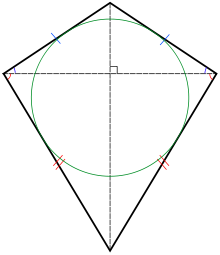Kite (geometry)
| Kite | |
|---|---|

A kite, showing its pairs of equal length sides and its inscribed circle.
|
|
| Type | Quadrilateral |
| Edges and vertices | 4 |
| Symmetry group | D1 (*) |
| Dual polygon | Isosceles trapezoid |
In Euclidean geometry, a kite is a quadrilateral whose four sides can be grouped into two pairs of equal-length sides that are adjacent to each other. In contrast, a parallelogram also has two pairs of equal-length sides, but they are opposite to each other rather than adjacent. Kite quadrilaterals are named for the wind-blown, flying kites, which often have this shape and which are in turn named for a bird. Kites are also known as deltoids, but the word "deltoid" may also refer to a deltoid curve, an unrelated geometric object.
A kite, as defined above, may be either convex or concave, but the word "kite" is often restricted to the convex variety. A concave kite is sometimes called a "dart" or "arrowhead", and is a type of pseudotriangle.
If all four sides of a kite have the same length (that is, if the kite is equilateral), it must be a rhombus.
If a kite is equiangular, meaning that all four of its angles are equal, then it must also be equilateral and thus a square. A kite with three equal 108° angles and one 36° angle forms the convex hull of the lute of Pythagoras.
The kites that are also cyclic quadrilaterals (i.e. the kites that can be inscribed in a circle) are exactly the ones formed from two congruent right triangles. That is, for these kites the two equal angles on opposite sides of the symmetry axis are each 90 degrees. These shapes are called right kites and they are in fact bicentric quadrilaterals (below to the left). Among all the bicentric quadrilaterals with a given two circle radii, the one with maximum area is a right kite.
...
Wikipedia
